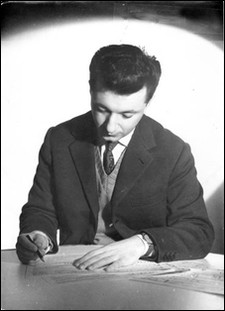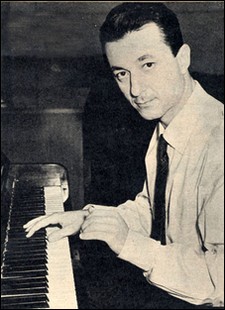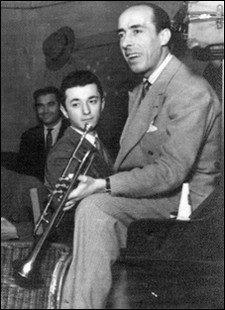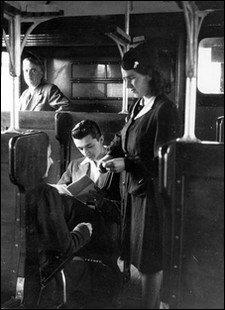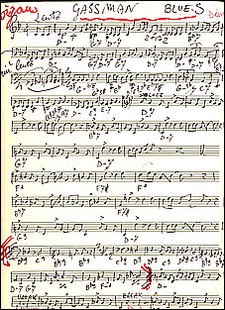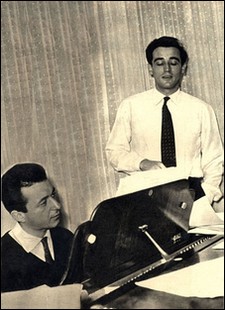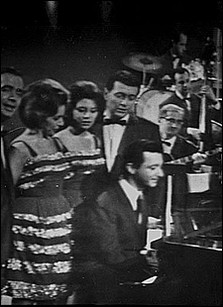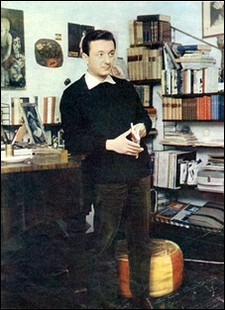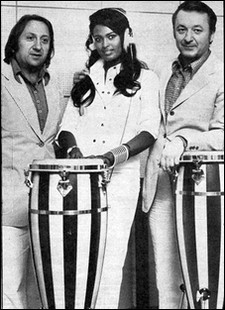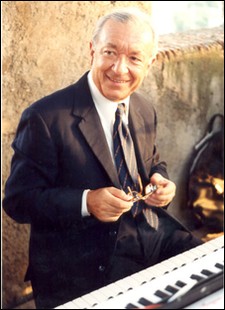Piero Umiliani - The Official Website - International Version
Main menu:
Piero Umiliani
Bio and News
Piero Umiliani, during his studies in the first Fifties at the Conservatorio Luigi Cherubini, Florence.
Piero Umiliani is born in Florence on July 17, 1926. At the age of five he discovers the piano of his maternal grandfather and he takes his first lessons from an aunt who teaches music. Whenever he can he thumps "Pippo non lo sa", a song by Gorni Kramer heard on the radio. At sixteen he begins to work with great satisfaction as a journalist for the newspaper Nuovo Giornale di Firenze but he runs into trouble when in an article he praises American jazz music, considered in those years music for "negros".
Maestro Pippo Barzizza, who is working for Radio Firenze and broadcasts American hits falsely presenting them as Italian after having changed their title on purpose, reads the article and wants to compliment himself with the author, obviously in secret. The appointment is in the Rai auditorium where an excited Piero listens to the Maestro Barzizza while directing the "Ruggito della Tigre" (the famous "Tiger Rag").
Piero would like to write more about music but his career is abruptly interrupted by the beginning of World War II. During those dark years, while his father Guido listens to Radio Londra, Piero or Pierino like everybody calls him, prefers to listen to the national Swiss radio that every evening devotes half hour to Duke Ellington’s music. His passion is born, but it is almost impossible to get hold of those records, in particular of "Mood Indigo", and many shop owners kick out of their stores the kids who dare to ask for that “bad stuff”.
Piero Umiliani in his recording studio during the sixties. In his career he wrotes more than 150 soundtracks.
THE PIANO PLAYER
With the arrival of the allied troops in 1944, just like his college friends who have to do all sorts of jobs to earn some money, he finds work as a piano player in a club frequented by Americans. In 1948 he graduates from Law School at the University of Florence, more to please his parents will than to follow his own vocation. He also registers at the Luigi Cherubini Conservatory and in 1952 he graduates in “Counterpoint and Fugue”. What seems to be just a pastime, while waiting for the newspaper to reopen, becomes his professional and artistic destiny. His close contacts with the Americans and the discovery of their music are determinant in his formation as a jazz pianist. In 1951 he goes to Milan where he makes with the Durium label the first 2 records in bebop style ever recorded in Italy (“Formula”, "Man Bop”, “Papirologia” and “Intrabop” are the track titles), sponsored by the Jazz Friends Association of Gianfranco Madini and where he plays with Oscar Valdambrini, Gianni Basso, Beppe Termini and Rodolfo Bonetto.
Only a few copies are made of these 78 RPM records (they have titles written in pen and a stamp with the catalogue number). However they are a fundamental chapter in the history of jazz “Made in Italy” and for Piero the time has come to broaden his music experience thanks to an international engagement.
In 1954 Piero and his jazz friends go to Norway where they play in Oslo clubs for over six months. The Masseglias Jazz Band (named after Aldo Masseglia, violinist and founder of the group) gain fame and the local newspapers show interest for the four “Italiensk” who play Italian classics and American jazz standards.
JAZZ A CINECITTA'
After his Norwegian experience he goes back to Florence for a short period and then he moves to Rome with the encouragement of Claudio Gambarelli, the first editor of his compositions for jazz bands. The Capital of Italy (…and of the Italian film industry) greets him in the best way. The brothers Paolo and Emilio Taviani ask him to write the music for their documentary "Pittori in città" (“Painters in the City”), the very first experience in this field for the young Maestro. This is only the start. In 1958 director Mario Monicelli contacts him for the soundtrack of the movie I Soliti Ignoti (“Big Deal on Madonna Street”). This is not just your ordinary soundtrack but it is the first Italian jazz soundtrack. The movie is included in the Academy Award nominations for Best Foreign Language Film of that year and even if the statue goes to “Mon Oncle” by Jacques Tati, a new era begins for Piero and for the world of soundtracks. The bond among jazz, cinema and the Maestro follows with movies like "L’Audace Colpo dei Soliti Ignoti" (“Fiasco in Milan”, 1959) with the trumpet of Chet Baker, Smog (1962) with Baker and the great vocalist Helen Merrill, "Una Bella Grinta" with the sax of Gato Barbieri, and "Accattone" by Pier Paolo Pasolini where Umiliani works with Maestro Rustichelli and the saxophone of Ivan Vandor. Umiliani’s versatility confronts him with all music styles and he works with great directors for all kinds of movies. He composes the soundtrack for "Il Vigile" (“The Traffic Policeman”) (1958) by Luigi Zampa with Alberto Sordi, "A Cavallo della Tigre" (“On the Tiger’s Back”) (1962) by Luigi Comencini with Nino Manfredi, and "La Celestina P.R:" by Carlo Lizzani (1964). In that same year, Umiliani’s “Piccola Suite Americana” wins the critics’ award for best Italian jazz record. He establishes the Omicron label with which he produces the first three of a long series of sonorization records to be utilized as background music in television productions. The theme “Chanel”, that piano player Oscar Peterson includes in his “Soft Sands” album, is in the second record, entitled “Musica per Due” (1964).
Florence, 1946.Piero Umiliani plays the piano in a dance ballroom. Most of the public were the soldiers of the American Militar Police.
The musical score of Gassman Blues, one of the most rilevant track from the OST of the movie ''I Soliti Ignoti''.
Piero Umiliani and Vittorio Gassman plays some songs for the TV show ''Il Mattatore'', aired on the RAI, the italian television, in 1959.
TV, CULT MOVIES & MUPPETS' SHOW
Betweeen the end of the 60’s and the beginning of the 70’s, Umiliani works for cult movies like “Cinque Bambole per la Luna d’Agosto” (“Five Dolls for an August Moon”) by Mario Bava with Edwige Fenech, “La Ragazza dalla Pelle di Luna” (“The Sinner”) by Luigi Scattini with Zeudi Araya, “Svezia, Inferno e Paradiso” (“Sweden Heaven and Hell”) also by Luigi Scattini in which Umiliani composes his famous Mah Nà Mah Nà and “La Pupa del Gagster” (“Get Rita”) starring the great couple Marcello Mastroianni and Sofia Loren directed by Giorgio Capitani. From the very beginning the Maestro works also for the radio and television. One of his first experiences is the Sanremo Festival (1957) in which he participates in the “free authors” section and then he continues with the music direction of the TV show Il Mattatore with Vittorio Gassman (1960). In the following years he hosts the TV shows Moderato Swing (1961) and Fuori l’Orchestra (1963) that bring jazz in the homes of the Italian audience, without mentioning the large number of themes composed by the Maestro for all kinds of TV programs. In 1969 the Maestro goes up music charts all over the world, when Mah nà Mah nà becomes the theme of the famous Muppets' Show created by Jim Henson. By the end of his career he has written more than 150 soundtracks, without considering the music composed for documentaries, theatre and television. He is also a great collector of music instruments from all over the world, and in 1970 he is one of the first in Italy to experiment with the Moog and other electronic keyboards. These experimentations, that anticipate the times, do not find the support of Italian producers and so Umiliani uses his own label to produce records like “Omaggio a Einstein”, “Tra Scienza e Fantascienza”, “Synthi Time”, “L’Uomo e la Città”. These records still sound incredibly modern and are real cult objects among collectors and Right Tempo label has recently reprinted some of them in CD format. Some of the greatest names of Italian culture ask for Umiliani’s collaboration in different projects. He composes the music for Cesare Zavattini’s docu-film “I Misteri di Roma”. Pier Paolo Pasolini is the author of the lyrics of songs written by Umiliani for Laura Betti. Dino Buzzati wants him to write the music for a new play. Towards the end of 1982 Umiliani decides to make a change in his career and to start playing with a Big Band in live concerts all over Italy bringing jazz to the great public, like Duke Ellington and Count Basie had done in the US. Unfortunately this exciting project is never carried through. In February 1984, Piero Umiliani suffers a stroke while coming back from the RAI studios in Via Asiago (Rome) after being interviewed on the radio. His life and career seem over, but it is not so.
Piero Umiliani, showman and musician for the TV Show ''Fuori l'Orchestra'', aired on the RAI, the Italian television, in 1963.
Diirector Luigi Scattini, Zeudi Araya and Piero Umiliani in studio for the sessions of the ''La Ragazza Fuoristrada'' soundtrack.
Piero Umiliani during a concert iin Ceri, a medieval town near Rome in 1990, the year of his comeback.
LOUNGE MAESTRO
After a long period of rehabilitation, the Maestro re-approaches music (or maybe it is music that re-approaches him). The rediscovery of lounge music and the revival of Italian soundtracks from the 70’s, utilized by a great fan of Umiliani’s music, American director Quentin Tarantino, coincide with his return on the scene, sitting at the piano that, note after note, brings him back to life. Concerts, reissues and rediscoveries of his records, participations to international festivals, all bring Umiliani’s music back to fame. His true love remains jazz and in 1991 there is the release of a new record, “Umiliani Jazz Family” that marks the debut of his daughter Alessandra as a vocalist, along with the collaboration of the sax of Giovanni Tommaso , the trumpet of Paolo Fresu and the drums of Gianpaolo Ascolese. The public finds new interest in large part of his discography, thanks to the reissues of Right Tempo, Cinevox, GDM, Cam and Cinedelic labels. The modernity of his music allows dee jays from all over the world to discover real gems in the immense repertory of soundtracks and sonorizations. Advertising agents go after his themes for their commercials. Artists like High Lamas, Cinematic Orchestra, Bentley Rhythm Aces, Pizzicato Five, Gak Sato, Kid Loco, DJ Spooky – only to cite a few – remix, sample, and re-interpret his themes in clubs all over the world. Umiliani’s new career continues until February 2001 when he suddenly passes away.
His music continues, unstoppable, to enchant the world. The international breath of Umiliani’s compositions is reconfirmed in 2005 when Steve Sodenbergh inserts the theme “Crepuscolo sul mare” (aka “Dawn on the Sea”) in the soundtrack of the movie “Ocean’s Twelve” starring George Clooney and Brad Pitt. The following year BBC devotes two episodes of a radiophonic special to the Maestro. In Rome at the Casa del Jazz during the festival of Cinema 2006, pianist Enrico Pierannunzi and his formation celebrate the Maestro with the concert Omaggio a Piero Umiliani. In 2007 the English group Cake makes a pop-rock version of “Mah Nà Mah Nà”, that the New York Post places among the best 15 covers in the history of music. In June 2008 during the Ravenna Festival, the Antonello Vannucchi Octet, formed in large part by musicians of Umiliani’s orchestra, performs at the “Teatro Socjale” a concert entirely devoted to his music. The year 2009 marks the return to fame of “Mah Nà Mah Nà” as official video of the Walt Disney Pictures movie “ Lilly the Witch: the Dragon and the Magical Book”, an international production by Academy Award winner director Stefan Ruzowitzki.
